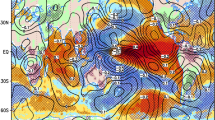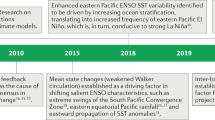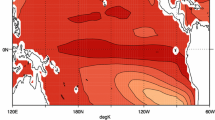Abstract
El Niño-Southern Oscillation (ENSO) is the dominant mode of climate variability, affecting climate conditions over large areas of the globe. There are, however, substantial differences in how ENSO teleconnections with regional climate variability are represented in different datasets such as gridded observations and climate models. Here we examine the global responses of temperature and precipitation over land to ENSO within a hierarchy of datasets with different levels of observational constraints. Anomaly maps of observed El Niño and La Niña responses are compared to reanalysis, atmospheric models driven by observed sea surface temperature (SST), and coupled atmosphere–ocean general circulation models. There is a gradual decline in anomaly pattern agreement relative to observations moving down the dataset hierarchy to lower observational constraints. We find a positive relationship between the models’ fidelity in representing ENSO temperature and precipitation, though the relationship is stronger for El Niño teleconnections than La Niña. The models also reproduce El Niño response patterns with greater fidelity than La Niña patterns. Additionally, the fidelity of model-simulated responses to El Niño is related to the magnitude of SST variability in the tropical Pacific, but no such relationship could be found for La Niña responses. This comprehensive evaluation highlights the importance of realistically simulating atmospheric circulation and SST variability to better capturing the patterns of regional climate variability in response to ENSO in climate models.














Similar content being viewed by others
References
Adler RF, Huffman GJ, Chang A, Ferraro R, Xie P, Janowiak J, Rudolf B, Schneider U, Curtis S, Bolvin D, Gruber A, Susskind J, Arkin P (2003) The version 2 global precipitation climatology project (GPCP) Monthly Precipitation Analysis (1979-Present). J Hydrometeorol 4:1147–1167
Andreoli RV, Kayano MT (2005) ENSO-related rainfall anomalies in South America and Associated Circulation Features during Warm and Cold Pacific Decadal Oscillation Regimes. Int J Climatol 25(15):2017–2030
Ashok K, Guan Z, Yamagata T (2001) Impact of the Indian Ocean Dipole on the Relationship between the Indian Monsoon Rainfall and ENSO. Geophys Res Lett 28(23):4499–4502
Ashok K, Behera S, Rao S, Weng H, Yamagata T (2007) El Niño Modoki and its possible teleconnection. J Geophys Res 112:C11007
Ashok K, Nagaraju C, Sen Gupta A, Pai DS (2014) Decadal changes in the relationship between the Indian and Australian Summer Monsoons. Clim Dyn 42(3):1043–1052
Bosilovich M, Chen J, Robertson F, Adler R (2008) Evaluation of global precipitation in reanalyses. J Appl Meteorol Climatol 47(9):2279–2299
Burgers G, Stephenson D (1999) The “normality” of El Niño. Geophys Res Lett 26(8):1027–1030
Cai W, Borlace S, Lengaigne M, van Rensch P, Collins M, Vecchi G, Timmermann A, Santoso A, McPhaden M, Wu L, England M, Wang G, Guilyardi E, Jin F (2014) Increasing frequency of extreme El Niño events due to greenhouse warming. Nat Clim Change 4(2):111–116
Cai W, Santoso A, Wang G, Yeh S, An S, Cobb K, Collins M, Guilyardi E, Jin F, Kug J, Lengaigne M, McPhaden M, Takahashi K, Timmermann A, Vecchi G, Watanabe M, Wu L (2015a) ENSO and greenhouse warming. Nat Clim Change 5(9):849–859
Cai W, Wang G, Santoso A, McPhaden M, Wu L, Jin F, Timmermann A, Collins M, Vecchi G, Lengaigne M, England M, Dommenget D, Takahashi K, Guilyardi E (2015b) Increased frequency of extreme La Niña events under greenhouse warming. Nat Clim Change 5(2):132–137
Cai W, Wu L, Lengaigne M, Li T, McGregor S, Kug J-S, Yu J-Y et al (2019) Pantropical climate interactions. Science 363(6430):eaav4236. https://doi.org/10.1126/science.aav4236
Capotondi A, Wittenberg A, Newman M, Di Lorenzo E, Yu J, Braconnot P, Cole J, Dewitte B, Giese B, Guilyardi E, Jin F, Karnauskas K, Kirtman B, Lee T, Schneider N, Xue Y, Yeh S (2015) Understanding ENSO diversity. Bull Am Meteorol Soc 96(6):921–938
Chan JCL, Zhou W (2005) PDO, ENSO and the early summer Monsoon Rainfall over South China. Geophys Res Lett 32(8):L08810
Copernicus Climate Change Service (C3S) (2017) ERA5: Fifth generation of ECMWF atmospheric reanalyses of the global climate. Copernicus Climate Change Service Climate Data Store (CDS), https://cds.climate.copernicus.eu/cdsapp#!/home. Accessed 23 Apr 2020
Dee DP et al (2011) The ERA-Interim reanalysis: configuration and performance of the data assimilation system. Q J R Meteorol Soc 137(656):553–597
Deser C, Simpson IR, Phillips AS, McKinnon KA (2018) How well do we know ENSO’s climate impacts over North America, and how do we evaluate models accordingly? J Clim 31(13):4991–5014
Dieppois B, Rouault M, New M (2015) The impact of ENSO on Southern African rainfall in CMIP5 ocean atmosphere coupled climate models. Clim Dyn 45(9–10):2425–2442
Frauen C, Dommenget D (2010) El Niño and La Niña amplitude asymmetry caused by atmospheric feedbacks. Geophys Res Lett 37(18):L18801
Frauen C, Dommenget D, Tyrrell N, Rezny M (2014) Analysis of the Non-Linearity of El Niño Southern Oscillation Teleconnections. J Clim 27:6225–6244
Gates WL et al (1999) An overview of the results of the atmospheric model intercomparison project (AMIP I). Bull Amer Meteor Soc 80:29–56. https://doi.org/10.1175/1520-0477(1999)080<0029:AOOTRO>2.0.CO;2
Guilyardi E, Gualdi S, Slingo J, Navarra A, Delecluse P, Cole J, Madec G, Roberts M, Latif M, Terray L (2004) Representing El Niño in coupled ocean-atmosphere GCMs: the dominant role of the atmospheric component. J Clim 17:4623–4629
Harris I, Jones PD, Osborn TJ, Lister DH (2014) Updated high-resolution grids of monthly climatic observations - the CRU TS3.10 dataset. Int J Climatol 34(3):623–642
Hersbach H, Peubey C, Simmons A, Berrisford P, Poli P, Dee D (2015) ERA-20CM: a twentieth-century atmospheric model ensemble. Q J R Meteorol Soc 141(691):2350–2375
Hill KJ, Taschetto AS, England MH (2011) Sensitivity of South American summer rainfall to Tropical Pacific Ocean SST anomalies. Geophys Res Lett 38(1):L01701
Hoerling MP, Kumar A, Zhong M (1997) El Niño, La Niña, and the nonlinearity of their teleconnections. J Clim 10:1769–1786
Huang B, Banzon V, Freeman E, Lawrimore J, Liu W, Peterson T, Smith T, Thorne P, Woodruff S, Zhang H (2015) Extended reconstructed sea surface temperature version 4 (ERSSTv.4). Part I: upgrades and intercomparisons. J Clim 28(3):911–930
Jourdain N, Gupta A, Taschetto A, Ummenhofer C, Moise A, Ashok K (2013) The Indo-Australian monsoon and its relationship to ENSO and IOD in reanalysis data and the CMIP3/CMIP5 simulations. Clim Dyn 41(11–12):3073–3102
Kajtar JB, Santoso A, McGregor S, England MH, Baillie Z (2018) Model under-representation of decadal Pacific trade wind trends and its link to tropical Atlantic bias. Clim Dyn 50(3–4):1471–1484
Kalnay E et al (1996) The NCEP/NCAR 40-year reanalysis project. Bull Amer Meteor Soc 77:437–472. https://doi.org/10.1175/1520-0477(1996)077<0437:TNYRP>2.0.CO;2
Kanamitsu M et al (2002) Ncep–doe amip-ii reanalysis (r-2). Bull Am Meteorol Soc 83(11):1631–1643
Kidston J, Gerber E (2010) Intermodel variability of the poleward shift of the austral jet stream in the CMIP3 integrations linked to biases in 20th century climatology. Geophys Res Lett 37(9):09708
Kim J-W, Yeh S-W, Chang E-C (2014) Combined effect of El Niño-Southern oscillation and Pacific decadal oscillation on the East Asian Winter Monsoon. Clim Dyn 42(3):957–971
King A, Alexander L, Donat M (2013) Asymmetry in the response of eastern Australia extreme rainfall to low-frequency Pacific variability. Geophys Res Lett 40(10):2271–2277
King A, Donat M, Alexander L, Karoly D (2015) The ENSO-Australian rainfall teleconnection in reanalysis and CMIP5. Clim Dyn 44(9–10):2623–2635
Kobayashi S, Ota Y, Harada Y, Ebita A, Moriya M, Onoda H, Onogi K et al (2015) The JRA-55 reanalysis: general specifications and basic characteristics. J Meteorol Soc Jpn 93(1):5–48
Langenbrunner B, Neelin J (2013) Analyzing ENSO teleconnections in CMIP models as a measure of model fidelity in simulating precipitation. J Clim 26(13):4431–4446
Lenssen N, Schmidt G, Hansen J, Menne M, Persin A, Ruedy R, Zyss D (2019) Improvements in the GISTEMP uncertainty model. J Geophys Res Atmos 124(12):6307–6326
Lim E, Hendon H (2015) Understanding and predicting the strong Southern Annular Mode and its impact on the record wet east Australian spring 2010. Clim Dyn 44(9–10):2807–2824
Marathe S, Ashok K, Swapna P, Sabin TP (2015) Revisiting El Niño modokis. Clim Dyn 45(11–12):3527–3545
McGregor S, Stuecker MF, Kajtar JB, England MH, Collins M (2018) Model tropical Atlantic biases underpin diminished Pacific decadal variability. Nat Clim Change 8(6):493–498
McPhaden M, Zebiak S, Glantz M (2006) ENSO as an integrating concept in earth science. Science 314(5806):1740–1745
Morice CP, Kennedy JJ, Rayner NA, Jones PD (2012) Quantifying uncertainties in global and regional temperature change using an ensemble of observational estimates: the HadCRUT4 dataset. J Geophys Res Atmos 117:D8. https://doi.org/10.1029/2011JD017187
Neale RB, Richter JH, Jochum M (2008) The impact of convection on ENSO: from a delayed oscillator to a series of events. J Clim 21(22):5904–5924
Nicholson S, Kim J (1997) The Relationship of the El Niño-Southern Oscillation to African Rainfall. Int J Climatol 17(2):117–135
Nobre P, Shukla J (1996) Variations of sea surface temperature, wind stress, and rainfall over the Tropical Atlantic and South America. J Clim 9:2464–2479
Perry SJ, McGregor S, Sen Gupta A, England MH, Maher N (2019) Projected late 21st century changes to the regional impacts of the El Niño-Southern oscillation. Clim Dyn. https://doi.org/10.1007/s00382-019-05006-6
Poli P, Hersbach H, Dee D, Berrisford P, Simmons A, Vitart F, Laloyaux P, Tan D, Peubey C, Thépaut J, Trémolet Y, Hólm E, Bonavita M, Isaksen L, Fisher M (2016) ERA-20C: an atmospheric reanalysis of the twentieth century. J Clim 29(11):4083–4097
Power SB, Delage FPD (2018) El Niño-Southern Oscillation and associated climatic conditions around the world during the latter half of the Twenty-First Century. J Clim 31(15):6189–6207
Power S, Casey T, Folland C, Colman A, Mehta V (1999) Inter-decadal modulation of the impact of ENSO on Australia. Clim Dyn 15(5):319–324
Power S, Delage F, Wang G, Smith I, Kociuba G (2017) Apparent limitations in the ability of CMIP5 climate models to simulate recent multi-decadal change in surface temperature: implications for global temperature projections. Clim Dyn 49(1–2):53–69
Rodrigues RR, Haarsma RJ, Campos EJD, Ambrizzi T (2011) The impacts of Inter-El Niño variability on the Tropical Atlantic and Northeast Brazil Climate. J Clim 24(13):3402–3422
Ropelewski C, Halpert M (1987) Global and regional scale precipitation patterns associated with the El Niño/Southern Oscillation. Mon Weather Rev 115(8):1606–1626
Scaife A, Woollings T, Knight J, Martin G, Hinton T (2010) Atmospheric blocking and mean biases in climate models. J Clim 23(23):6143–6152
Schneider U, Becker A, Finger P, Meyer-Christoffer A, Rudolf B, Ziese M (2011) GPCC full data reanalysis version 6.0 at 1.0°: monthly land-surface precipitation from Rain-Gauges built on GTS-based and Historic Data. https://doi.org/10.5676/dwd_gpcc/fd_m_v7_100
Taschetto AS, Ummenhofer CC, Sen Gupta A, England MH (2009) Effect of anomalous warming in the Central Pacific on the Australian Monsoon. Geophys Res Lett 36:L12704
Taschetto AS, Sen Gupta A, Hendon H, Ummenhofer CC, England MH (2011) The contribution of Indian Ocean Sea surface temperature anomalies on Australian Summer Rainfall during El Niño Events. J Clim 24(14):3734–3747
Taschetto AS, Sen Gupta A, Jourdain N, Santoso A, Ummenhofer CC, England MH (2014) Cold tongue and warm pool ENSO events in CMIP5: mean state and future projections. J Clim 27(8):2861–2885
Taylor K, Stouffer R, Meehl G (2012) An overview of CMIP5 and the experiment design. Bull Am Meteorol Soc 93(4):485–498
Tedeschi R, Cavalcanti I, Grimm A (2013) Influences of two types of ENSO on South American precipitation. Int J Climatol 33(6):1382–1400
Trenberth KE, Stepaniak DP (2001) Indices of El Niño Evolution. J Clim 14(8):1697–1701
Trenberth KE, Branstator GW, Karoly D, Kumar A, Lau N-C, Ropelewski C (1998) Progress during TOGA in understanding and modeling global teleconnections associated with Tropical sea surface temperatures. J Geophys Res 103(C7):14291–14324
Ummenhofer C, England M, McIntosh P, Meyers G, Pook M, Risbey J, Sen Gupta A, Taschetto AS (2009) What causes southeast Australia’s worst droughts? Geophys Res Lett 36(4):1–6
Ummenhofer C, Sen Gupta A, Li Y, Taschetto AS, England M (2011) Multi-decadal modulation of the El Niño-Indian monsoon relationship by Indian Ocean variability. Environ Res Lett 6(3):034006
Weare B (2012) El Niño teleconnections in CMIP5 models. Clim Dyn 41(7–8):2165–2177
Weng H, Ashok K, Behera SK, Rao SA, Yamagata T (2007) Impacts of recent El Niño Modoki on dry/wet conditions in the Pacific Rim during Boreal Summer. Clim Dyn 29(2–3):113–129
Wilks DS (1995) Statistical methods in the atmospheric sciences: an introduction. Academic Press, Cambridge, p 467
Wittenberg AT (2009) Are historical records sufficient to constrain ENSO simulations? Geophys Res Lett 36(12):L12702. https://doi.org/10.1029/2009GL038710
Xie P, Arkin PA (1997) Global precipitation: a 17-year monthly analysis based on gauge observations, satellite estimates, and numerical model outputs. Bull Am Meteorol Soc 78:2539–2558
Yeh S, Cai W, Min S, McPhaden M, Dommenget D, Dewitte B, Collins M, Ashok K, An S, Yim B, Kug J (2018) ENSO atmospheric teleconnections and their response to greenhouse gas forcing. Rev Geophys 56(1):185–206
Yoon J, Yeh S-W (2010) Influence of the Pacific decadal oscillation on the relationship between El Niño and the Northeast Asian Summer Monsoon. J Clim 23(17):4525–4537
Yulaeva E, Wallace JM (1994) The signature of ENSO in global temperature and precipitation fields derived from the microwave sounding unit. J Clim 7(11):1719–1736
Zhu J, Kumar A, Wang W, Hu Z-Z, Huang B, Balmaseda AA (2017) Importance of convective parameterization in ENSO predictions. Geophys Res Lett 44(12):6334–6342
Zou Y, Yu J, Lee T, Lu M, Kim S (2014) CMIP5 model simulations of the impacts of the two types of El Niño on the U.S. winter temperature. J Geophys Res Atmos 119(6):307
Zwiers FW, von Storch H (1995) Taking serial correlation into account in tests of the mean. J Clim 8:336–351
Acknowledgements
This study was supported by funding from the Australian Research Council Centre for Climate Extremes and Climate Change Research Centre, University of New South Wales, Sydney, Australia. This project was undertaken with the assistance of resources and services from the National Computational Infrastructure (NCI), which is supported by the Australian Government. AST is supported by the Australian Research Council (FT160100465). We thank the reviewers for their constructive comments and suggestions that contributed to the improvement of this study.
Author information
Authors and Affiliations
Corresponding author
Additional information
Publisher's Note
Springer Nature remains neutral with regard to jurisdictional claims in published maps and institutional affiliations.
Electronic supplementary material
Below is the link to the electronic supplementary material.
Rights and permissions
About this article
Cite this article
Garcia-Villada, L.P., Donat, M.G., Angélil, O. et al. Temperature and precipitation responses to El Niño-Southern Oscillation in a hierarchy of datasets with different levels of observational constraints. Clim Dyn 55, 2351–2376 (2020). https://doi.org/10.1007/s00382-020-05389-x
Received:
Accepted:
Published:
Issue Date:
DOI: https://doi.org/10.1007/s00382-020-05389-x




